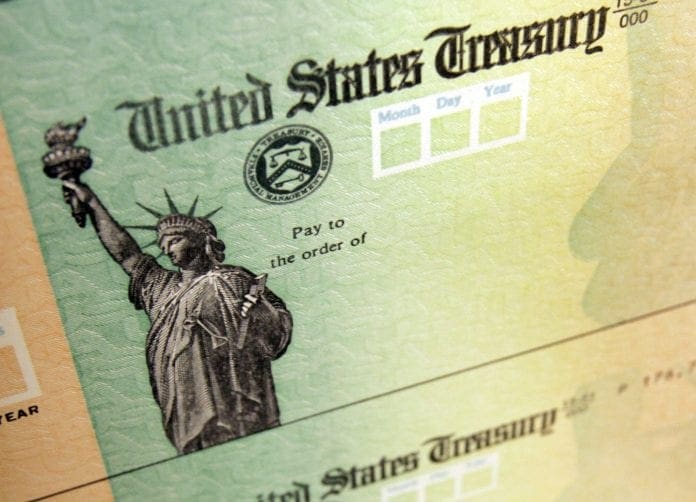The rush by an increasing number of states to send inflation relief stimulus checks to residents is justified by the inflation rate continuing to touch record figures each month. It crossed the 9.1% mark in June, the highest since November 1984. While federal lawmakers have contemplated alternative measures to help Americans cope with the debilitating effect of inflation, little has borne fruit so far.
Any federal initiative is facing a gridlock in the Senate and the House as Republicans have vehemently opposed any form of stimulus check after the economic impact payment, which is part of the American Rescue Plan Act.
But funds sent under the very same scheme to states and local bodies are coming in handy for states, both Democratic and Republican, who are using it to give out inflation relief stimulus checks to residents or are in the process of legislating on it.
The ARPA included $350 billion in emergency funds to local, tribal, and territorial bodies, and state governments. State governments and the Dist. of Columbia received $195.3 billion of the state portion of the recovery fund over two tranche disbursements.
Most states are in the process of making use of these funds to provide inflation relief to residents in the form of stimulus checks, sales and income tax relief, general tax rebates, rebates on affected goods like gasoline and groceries, and gas and transport rebates cards.
Economic Boom In 2021 Helped States Build Up Budget Surplus
After an early decline immediately after the pandemic hit America, states collectively amassed their largest ever fiscal cushion on record by the start of the current budget year. Tax revenues were way higher than expected and drove the total held in savings and leftover budget amount to new highs. With states approaching the close of the 2022 fiscal year, most states expect to spend down at least a part of their surplus funds to support residents hit hard by inflation.

Despite the debilitating effect of the pandemic and the three-month recession that followed, the rainy day fund amassed by the states went down only marginally in 2020, the year the economy was worst affected by the COVID-19 pandemic.
And during 2021 fiscal, the state increased its collective backup funds by $37.7 billion, an increase that came to around 50% from the previous year. This drove the total amount held by states to a record figure of $114.6 billion.
The widespread budget surplus was also followed by the largest increase annually in the leftover general fund money, also known as the ending balance, in at least 21 years previously.
These budget stabilization funds, or the rainy day funds, grew in over 35 states in 2021. With these huge savings, states could afford to run government operations on their rainy day funds alone for a median of more than 30 days, 34.4 to be exact.
Though states have avoided tapping into these rainy day funds since the onset of the pandemic and the recession in the first two quarters of 2020. States initially moved cautiously over using these dedicated savings amounts due to the uncertainty of how the pandemic and subsequent recession would play out.
They have also supported their decision thanks to the availability of additional federal funding. Instead of first going for state savings, most of them managed their gaps in the 2020 fiscal budget through a combination of several factors. This included spending early federal aid to state governments, deeper spending cuts, and a record high cache of ending balances that built up over two previous years of widespread revenue surpluses.
Using Budget Surplus And ARPA Funds To Send Inflation Relief Stimulus Checks To Residents
The end of the stimulus check support afforded to residents meant that citizens found themselves without jobs even as millions continued to find that they could not balance their budget despite a small increase in wages in 2022 over pre-pandemic figures.
Close to 20 states have moved to with stimulus checks for their residents with California and Florida among the latest to join the list. While the Democrat-ruled California is making maximum use of its huge surplus of $97 billion to send stimulus checks of up to $1,050 to around 23 million of its residents, Florida will e sending a $450 stimulus check intended for children. Related and non-related caregivers will be among those benefitting from the payments.


California is giving out a $350 stimulus check to both files in the case of a joint filing. Even one dependent will benefit from the same amount which comes around to the maximum of $1,050. This stimulus check is only for residents who jointly earn below $150,000. Individual residents earning an amount of $75.000 will get an identical amount, which works out to $700 in case the filer has at least one dependent.
Maine and New Mexico are among states that have already legislated on the issue and have started sending out stimulus checks. Maine is among the most generous of states and will be sending out an $850 stimulus check to eligible residents and double that for married couples filing jointly.
The majority of Coloradans are set to receive a stimulus check by the end of next week or by the week after. People who have filed their state income tax returns by October 17 will receive their stimulus checks by January 2023.
The rebate comes out to $750 for individuals and $1,500 for people who file their taxes jointly. Officials say that around 2.4 million or the stimulus checks will not reach beneficiaries but will instead be held back partially or even fully to adjust for back taxes and child support dues.
Residents must file their returns for 2021 even if their income is below the taxable limit. Or they must have applied for a credit rebate on property tax, rent, and heat, by the end of June. A resident must also be a resident for a full year in Colorado and should be 18 years in case of filing by a child.
The TABOR funds might have come back to taxpayers none way or another. But Democrats in Colorado have succeeded in releasing the funds sooner and in a fashion that they say is more equitable.






